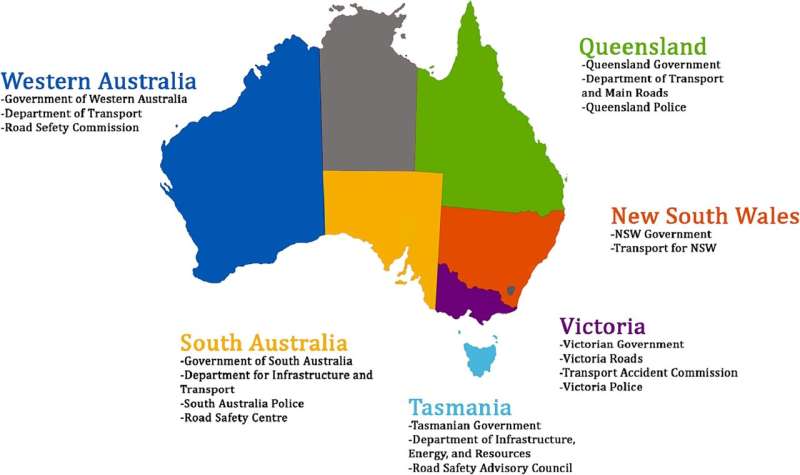
In a study published in Safety Science, QUT researchers say several sources of distraction have been overlooked in official distraction-related information and road rules for car drivers in Australia.
QUT Ph.D. student Sina Rejali teamed up with Center for Accident Research and Road Safety—Queensland (CARRS-Q) Research Fellow Dr. Natalie Watson-Brown and Senior Research Fellow Dr. Sherrie-Anne Kaye, to critically investigate the official distraction-related information and road rules for car drivers in Australia.
Rejali said “distracted driving” referred to any activity that diverted the driver’s attention from safe driving. “Distracted driving is one of the leading cause of crashes, even in countries with advanced road safety systems like Australia.
“Governments in Australia often use public education campaigns and road rules as countermeasures to address distracted driving, but these may not effectively deter distracted driving in some cases.
“There is a general lack of understanding about the risks associated with driver distractions.”
Rejali said the study aimed to investigate the current official information and road rules related to driver distractions provided by state governments in Australia.
“The study assessed the completeness and limitations of government information and road rules, focusing on how distraction is specifically addressed.
“Findings suggested that official information and road rules about distracted driving predominantly focus on mobile phone use,” Rejali said.
Rejali said some sources of distraction, particularly internal distractions such as medical impairments and external distractions like advertising billboards, were overlooked or received limited attention. “And the information does not adequately address the specific needs of certain road users, such as young and inexperienced drivers.”
Rejali said guidelines for safe interaction with some in-vehicle distractions were inconsistent across jurisdictions. “The rules around modern gadgets such as smartwatches, computer-driven advanced driving assistance systems, and even traveling with pets that are strapped in or not, are subject to differing rules across the various jurisdictions.”
Rejali said general rules regarding distracted driving, such as those related to careless driving, lacked specificity. “The results of this investigation highlight the need for a more holistic approach to managing driver distractions.
“Information on sources of distraction should be provided for drivers in a more comprehensive way to cover the different aspects of distracted driving.
“The information is fragmented with a heavy emphasis on mobile phones currently. Information should be tailored to specific road user groups, such as young drivers.
“At the moment both the content and its delivery may not be completely effective in helping young drivers understand the range of distracted driving behaviors and their consequences.”
More information:
Sina Rejali et al, Is official information about distracted driving enough? A critical investigation of Government-provided information and road rules in Australia, Safety Science (2024). DOI: 10.1016/j.ssci.2024.106519
Queensland University of Technology
Research finds rules and information governing distracted driving lacking (2024, June 26)
retrieved 26 June 2024
from https://techxplore.com/news/2024-06-distracted-lacking.html
part may be reproduced without the written permission. The content is provided for information purposes only.

In a study published in Safety Science, QUT researchers say several sources of distraction have been overlooked in official distraction-related information and road rules for car drivers in Australia.
QUT Ph.D. student Sina Rejali teamed up with Center for Accident Research and Road Safety—Queensland (CARRS-Q) Research Fellow Dr. Natalie Watson-Brown and Senior Research Fellow Dr. Sherrie-Anne Kaye, to critically investigate the official distraction-related information and road rules for car drivers in Australia.
Rejali said “distracted driving” referred to any activity that diverted the driver’s attention from safe driving. “Distracted driving is one of the leading cause of crashes, even in countries with advanced road safety systems like Australia.
“Governments in Australia often use public education campaigns and road rules as countermeasures to address distracted driving, but these may not effectively deter distracted driving in some cases.
“There is a general lack of understanding about the risks associated with driver distractions.”
Rejali said the study aimed to investigate the current official information and road rules related to driver distractions provided by state governments in Australia.
“The study assessed the completeness and limitations of government information and road rules, focusing on how distraction is specifically addressed.
“Findings suggested that official information and road rules about distracted driving predominantly focus on mobile phone use,” Rejali said.
Rejali said some sources of distraction, particularly internal distractions such as medical impairments and external distractions like advertising billboards, were overlooked or received limited attention. “And the information does not adequately address the specific needs of certain road users, such as young and inexperienced drivers.”
Rejali said guidelines for safe interaction with some in-vehicle distractions were inconsistent across jurisdictions. “The rules around modern gadgets such as smartwatches, computer-driven advanced driving assistance systems, and even traveling with pets that are strapped in or not, are subject to differing rules across the various jurisdictions.”
Rejali said general rules regarding distracted driving, such as those related to careless driving, lacked specificity. “The results of this investigation highlight the need for a more holistic approach to managing driver distractions.
“Information on sources of distraction should be provided for drivers in a more comprehensive way to cover the different aspects of distracted driving.
“The information is fragmented with a heavy emphasis on mobile phones currently. Information should be tailored to specific road user groups, such as young drivers.
“At the moment both the content and its delivery may not be completely effective in helping young drivers understand the range of distracted driving behaviors and their consequences.”
More information:
Sina Rejali et al, Is official information about distracted driving enough? A critical investigation of Government-provided information and road rules in Australia, Safety Science (2024). DOI: 10.1016/j.ssci.2024.106519
Queensland University of Technology
Research finds rules and information governing distracted driving lacking (2024, June 26)
retrieved 26 June 2024
from https://techxplore.com/news/2024-06-distracted-lacking.html
part may be reproduced without the written permission. The content is provided for information purposes only.








